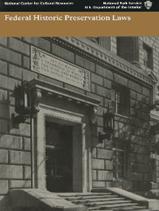- Reclamation
- Cultural and Paleontological Resources
- Legislative Mandates
Legislative Mandates
 An array of Federal laws exist to preserve and protect the Nation's cultural heritage. Below you will find links to the full text of the major Federal laws, regulations, standards and guidelines, and executive orders related to cultural resources management. Additional links to laws, executive orders, and regulations can be found on the National Park Service's History and Culture site. Additional links to standards and guidelines for preservation can also be found on the National Park Service's History and Culture site. Federal Historic Preservation Case Law, 1966-2000, is available through the Advisory Council on Historic Preservation.
An array of Federal laws exist to preserve and protect the Nation's cultural heritage. Below you will find links to the full text of the major Federal laws, regulations, standards and guidelines, and executive orders related to cultural resources management. Additional links to laws, executive orders, and regulations can be found on the National Park Service's History and Culture site. Additional links to standards and guidelines for preservation can also be found on the National Park Service's History and Culture site. Federal Historic Preservation Case Law, 1966-2000, is available through the Advisory Council on Historic Preservation.
Key: PL is for Public Law
Stat. is for Statute
USC is the U.S. Code
CFR is
the Code of Federal Regulations
Laws
Antiquities Act of 1906, as amended (PL 59-209; 34 Stat. 225; 16 USC 431-433) is the earliest and most basic legislation for protecting cultural resources on Federal lands. It provides misdemeanor-level criminal penalties to control unauthorized uses. Appropriate scientific uses may be authorized through permits, and materials removed under a permit must be permanently preserved in a public museum. The 1906 Act is broader in scope than the 1979 Archaeological Resources Protection Act, which partially supersedes it. Uniform regulations at 43CFR Part 3 implement the Act.
American Indian Religious Freedom Act of 1978, as amended (PL 95-431; 92 Stat. 469; 42 USC 1996) resolves that it shall be the policy of the United States to protect and preserve for the American Indian, Eskimo, Aleut, and Native Hawaiian the inherent right of freedom to believe, express, and exercise their traditional religions, including access to religious sites, use and possession of sacred objects, and freedom to worship through ceremonial and traditional rites. Federal agencies are directed to evaluate their policies and procedures to determine if changes are needed to protect such rights and freedoms from agency practices. The act is a specific expression of First Amendment guarantees of religious freedom. It is not implemented by regulations.
Archeological and Historic Preservation Act of 1974 amended the Reservoir Salvage Act of 1960 (PL 86-523; 74 Stat. 220, 221; 16 USC 469; PL 93-291; 88 Stat. 174; 16 USC 469) and provides for the preservation of historical and archaeological data that might otherwise be lost as the result of Federal construction projects or Federally-licensed or assisted programs. The act provides that up to one percent of congressionally authorized funds for a project may be spent from appropriated project funds to recover, preserve, and protect archaeological and historical data.
Archeological Resources Protection Act of 1979, as amended (PL 96-95; 93 Stat. 721; 16 USC 47Oaa et seq.) has felony-level penalties for excavating, removing, damaging, altering, or defacing any archaeological resource more than 100 years of age, on public or Indian lands, unless authorized by a permit. It prohibits the sale, purchase, exchange, transportation, receipt, or offering of any archaeological resource obtained in violation of any regulation or permit under the act or under any Federal, State, or local law. The Act's definitions, permit requirements, and criminal and civil penalties augment the Antiquities Act, which it partially supersedes. It is implemented by uniform regulations and Interior-specific regulations, both at 43 CFR Part 7.
Historic Sites Act of 1935, as amended (PL 74-292; 49 Stat. 666; 16 USC 461) declares national policy to identify and preserve nationally significant "historic sites, buildings, objects and antiquities." It authorizes the National Historic Landmarks program and provides the foundation for the National Register of Historic Places authorized in the National Historic Preservation Act of 1966. Regulations implementing the National Historic Landmarks Program are at 36 CFR Part 65.
National Environmental Policy Act of 1969, as amended (42 USC 4321, and 4331 - 4335) states it is the Federal government's continuing responsibility to use all practicable means to preserve important historic, cultural, and natural aspects of our national heritage. It also instructs Federal agencies to prepare environmental impact statements for each major Federal action having an effect on the environment.
National Historic Preservation Act of 1966, as amended (PL 89-665; 80 Stat. 915; 16 USC 470), creates the National Register of Historic Places and extends protection to historic places of State and local as well as national significance. It establishes the Advisory Council on Historic Preservation, State Historic Preservation Officers, Tribal Preservation Officers, and a preservation grants-in-aid program. Section 106 directs Federal agencies to take into account effects of their actions ("undertakings") on properties in or eligible for the National Register, and Section 110(a) sets inventory, nomination, protection, and preservation responsibilities for Federally-owned cultural properties. Section 110(c) requires each Federal agency to designate a Preservation Officer to coordinate activities under the act. Section 106 of the act is implemented by regulations of the Advisory Council on Historic Preservation, 36 CFR Part 800. The Department of the Interior criteria and procedures for evaluating a property's eligibility for inclusion in the National Register are at 36 CFR Part 60.
Native American Graves Protection and Repatriation Act of 1990, as amended (PL 101-601; 104 Stat. 3048; 25 USC 3001 et seq.) establishes rights of Indian tribes and Native Hawaiian organizations to claim ownership of certain cultural items,including human remains, funerary objects, sacred objects, and objects of cultural patrimony, held or controlled by Federal agencies and museums that receive Federal funds. It requires agencies and museums to identify holdings of such remains and objects, and to work with appropriate Native Americans toward their repatriation. Permits for the excavation and/or removal of cultural items protected by the act require Native American consultation, as do discoveries of cultural items made during Federal land use activities. The Secretary of the Interior's implementing regulations are at 43 CFR Part 10.
Paleontological Resources Preservation Act of 2009 (16 USC 470aaa-aaa-11) requires the U.S. Department of Agriculture and the Department of the Interior to manage and protect paleontological resources on Federal land using scientific principles and expertise. The law, which applies only to Federal land, includes criminal and civil penalties for fossil theft and vandalism. The law also provides authority for issuing permits for collecting paleontological resources. The Department of the Interior is in the process of developing implementing regulations for this Act.
Reservoir Salvage Act of 1960 , as amended (16 USC 469-469c) extended the Historic Sites Act of 1935. It gave the Department of the Interior, through the National Park Service, major responsibility for preservation of archaeological data that might be lost specifically through dam construction.
1970 UNESCO Convention on the Means of Prohibiting and Preventing the Illicit Import, Export, and Transfer of Ownership of Cultural Property (19 USC 2601)
Regulations
Curation of Federally-Owned and Administered Archeological Collections (36 CFR Part 79)
Determinations of Eligibility for Inclusion in the National Register (36 CFR Part 63)
National Historic Landmarks Program (36 CFR Part 65)
National Register of Historic Places (36 CFR Part 60)
Native American Graves Protection and Repatriation Act: Final Rule
(43 CFR Part 10)
Preservation of American Antiquities (43 CFR Part 3)
Procedures for State, Tribal, and Local Government Historic Preservation Programs (36 CFR Part 61)
Protection of Archeological Resources (43 CFR Part 7)
Protection of Historic Properties (36 CFR Part 800)
Standards
Guidelines for Federal Agency Responsibilities, Under Section 110 of the National Historic Preservation Act
The Secretary of the Interior's Standards and Guidelines for Archeology and Historic Preservation [As amended and annotated by the National Park Service]
 The Secretary of the Interior's Standards for Architectural and Engineering Documentation
The Secretary of the Interior's Standards for Architectural and Engineering Documentation
The Secretary of the Interior's Professional Qualification Standards
(36 CFR Part 61)
The Secretary of the Interior's Standards for Rehabilitation (36 CFR 67)
The Secretary of the Interior's Standards for the Treatment of Historic Properties (36 CFR 68)
Executive Orders
Consultation and Coordination with Indian Tribal Governments 2000), Executive Order 13175
Preserve America (2003), Executive Order 13287, directs Federal agencies to improve their management of historic properties and to foster heritage tourism in partnership with local communities.
Protection and Enhancement of the Cultural Environment (1971), Executive Order No. 11593, directs Federal agencies to inventory cultural properties under their jurisdiction, to nominate to the National Register all Federally-owned properties that meet the criteria, to use due caution until the inventory and nomination processes are completed, and also to assure that Federal plans and programs contribute to preservation and enhancement of non-Federal properties. Some of the provisions of the Executive Order were turned into Section 110 of the National Historic Preservation Act.
.


